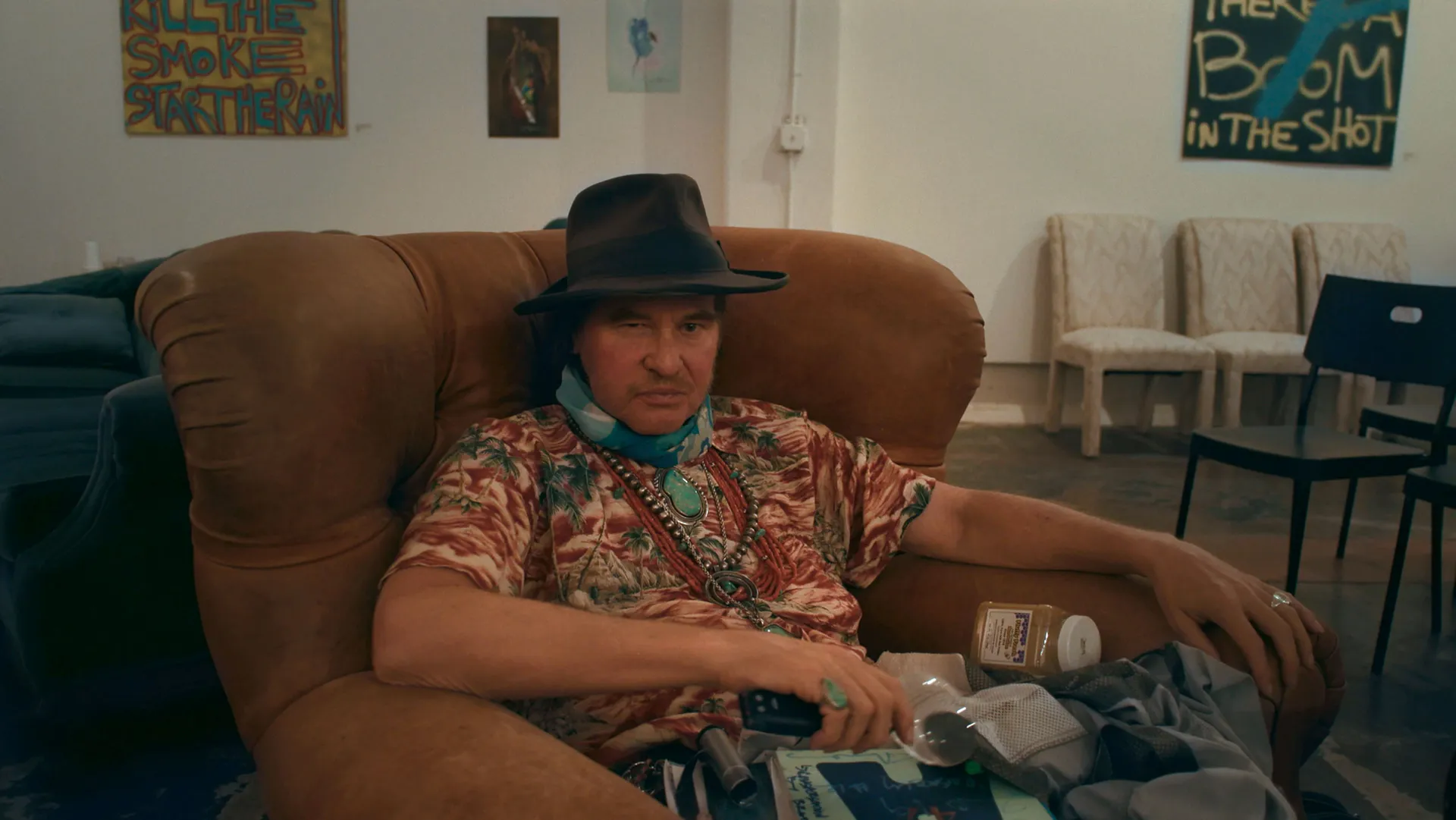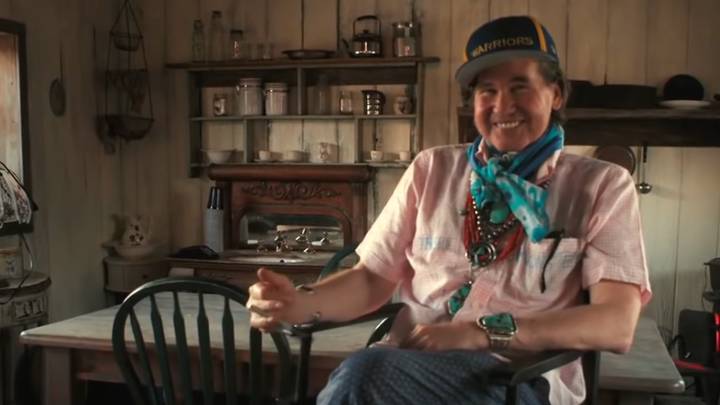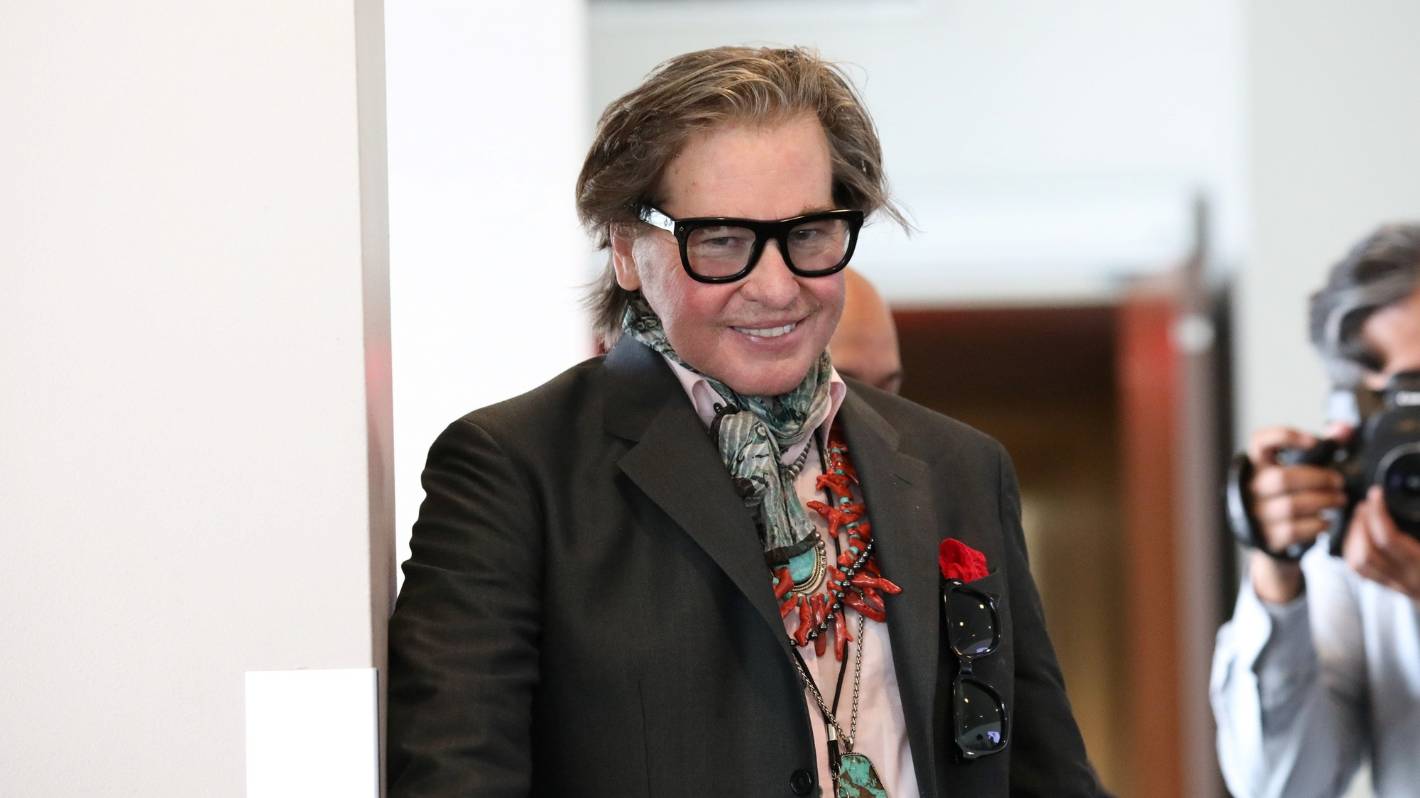It’s ineffably painful, in the new documentary “Val,” to see Val Kilmer, an actor still in his prime, enduring the effects of throat cancer. His treatment for the disease, which involved a tracheostomy, led to the extreme impairment of his voice—for the most part, he needs to cover a hole in a small plastic prosthesis in order to speak, and the result is a diminished monotone. (The movie features subtitles when he speaks.) “Val,” directed by Leo Scott and Ting Poo, is nonetheless Kilmer’s self-portrait and autobiography. It is not a great film—its form is less personal than its substance, its revelations and insights come only intermittently. Yet it is, in its key moments, something equally significant: it offers Kilmer a showcase that he has been denied, not only by the ravages of cancer but, long before, by the troubled course of his career and the inherent obstacles of Hollywood filmmaking.
Early in the documentary, Kilmer declares that he had long wanted to deliver his thoughts about the art of acting, which he also knows will be the story of his life. It takes him a while to do so in “Val”—and it’s only when he does, more than fifty minutes into the nearly two-hour film, that the movie takes flight—as he uninhibitedly vents pent-up frustration and disillusionment with ostensible highlights of his career. Up to that point in the movie, the story of Kilmer’s childhood and early career, while filled with heartfelt recollections and reflections of his family life (much of it by way of a monologue written by Kilmer and spoken by his son, Jack), remains somewhat hazy and diffuse—with one startling, anguished exception.
Throughout childhood, long before the prospect of an acting career presented itself, Kilmer was not only an enthusiastic and joyful performer but also a moviemaker himself. “Val” is replete with the films and videos that Kilmer made as a child, a teen, a young adult, and a full-blown professional (and also a husband and father)—he has, he says, thousands of hours of videos and films—and it also offers clips from an exceptionally poignant body of work, the short fiction films that he made with his younger brother Wesley. In 1977, Wesley, a teen-ager, drowned in the family hot tub as a result of an epileptic seizure. Kilmer talks of getting the news just before beginning his studies at Juilliard’s Drama Division, and his personal grief had an implicitly public dimension: he considered Wesley to be both his own crucial collaborator, his “confidant,” and an incipient great director (“an artistic genius”) with a major career ahead of him.

Kilmer doesn’t make it explicit, but the gaping hole in his career, as presented in the film, is the absence of Wesley—of a director who would be more than a director, who would be a collaborator uniquely attuned to Kilmer’s fragile and volatile art. As “Val” shows, from the time that Kilmer hit Juilliard, he was more than an actor—a play that he co-wrote, “How It All Began,” was performed while he was still in school and then was picked up by the Public Theater. He intended to make a career onstage; in his memoir, he recalls turning down a role in Francis Ford Coppola’s “The Outsiders” in favor of a play. In “Val,” he recalls that, when his movie career got under way, with “Top Secret!,” he deprecated it as “fluff.”
Yet he hardly managed to shift to his desired path; he didn’t want to do “Top Gun,” he recalls, because he found the script “silly” and “warmongering.” He was frustrated by the roles that were available; he wanted to be in Stanley Kubrick’s “Full Metal Jacket” and Martin Scorsese’s “Goodfellas” and made his own audition tapes for them, to no avail. He made one of himself as Jim Morrison, for Oliver Stone’s film “The Doors,” and got the part. He took the role of Doc Holliday, in the 1993 film “Tombstone,” very seriously, and describes the trick that he employed to emphasize the extreme—and real—physicality of his performance.
It is in contemplating that movie’s latter-day legacy that “Val” kicks into high emotional gear. He travels to Texas for an on-location screening of “Tombstone” complete with his public appearance in front of a large and adoring crowd, and it leaves him melancholy, as he says in voice-over:
Sometimes I feel so low and I have the blues really, really hard about having to, you know, fly around the country. I don’t look great and I’m selling basically my old self, my old career. For many people it’s like the lowest thing you can do is talk about your old pictures and sell photographs of when you were Batman or the Terminator. I don’t want to insult any of the other actors that fly around the world, but it enables me to meet my fans and what ends up happening is that I feel really grateful rather than humiliated because there’s so many people.

For Kilmer, the height of his celebrity came with his starring role in “Batman Forever,” from 1995. “By Hollywood standards, Batman is the ultimate leading role and a dream come true. I took the part without even reading the script,” he says. But then he catalogues the stages of his disillusionment: “whatever boyish excitement I had going in was crushed by the reality of the Batsuit.” The film includes an archival clip of Kilmer speaking of the constraints imposed by the suit, and features him now detailing those constraints, which were as physically demanding and as socially isolating as they were inhibiting for his performance. The suit, which concealed half of Kilmer’s face, changed his conception of the part: “I realized that my role in the film was just to show up and stand where I was told to.” He says that he acted in it like “an actor on a soap opera.” What he ultimately realized, he says, is that “Yes, every boy wants to be Batman. They actually want to be him. They don’t necessarily want to play him in a movie.”
Kilmer’s response was to turn down the sequel—in favor of “The Saint,” which, he thought, would offer him a more gratifying role. But the movie that really excited him was “The Island of Dr. Moreau,” because he’d get to act alongside Marlon Brando—and the experience proved to be yet another disillusionment, and a particularly bitter one. That story is the basis for one of two conjoined high points in “Val.” It is five minutes of footage that Kilmer himself recorded, of the cast and crew of “The Island of Dr. Moreau,” and it’s a miniature masterstroke of personal cinema, and of filmmaking about filmmaking.
Kilmer delivers, in Jack’s voice, bits of reminiscence to set up the drama: the original director, Richard Stanley, was fired soon after the start of the shoot and replaced with the veteran John Frankenheimer, who, according to Kilmer, in his effort to bring the film in on schedule, “was unwilling to take the time to explore Marlon’s ideas.” As a result, Brando “stopped trying to inject his own genius into the film,” Kilmer says, an artistic turn of events that Kilmer found “devastating.” There was no love lost between Kilmer and Frankenheimer; the actor says, into his own camera, “You know, John Frankenheimer can say ‘Action’ and ‘Cut’ all day long and it will never make him a director.” The longest and most powerful segment of Kilmer’s footage shows their conflict breaking out into the open on the set, when Frankenheimer was preparing to rehearse and Kilmer insisted on filming the activities with his video camera, telling the director, “I need a witness because of things you’ve said.” Frankenheimer demands that Kilmer shut it, and Kilmer refuses, continuing to film by tilting the camera down toward the floor and recording the sound of their bitter wrangling.

A home video that’s placed in “Val” a couple of minutes after the “Island” sequence shows Kilmer chopping off his long hair with a knife while lamenting the toll that acting in Hollywood movies takes on him: “They actually buy your life for a period of time, your experience, your opinions, your soul, in a way,” he says. (One unaddressed peculiarity of the documentary is the provenance of Kilmer’s archival videos. He’s been an enthusiastic home videographer ever since VHS camcorders came on the market, but much of the amateur footage that’s included in “Val” appears to be footage of him, not by him, as if he’d been arranging for much of his life to be documented on video by others.) Interviewed on television by Larry King, Kilmer says, “I’m frustrated because what I have to do isn’t getting filmed, because the director isn’t able to bring it out.” In a home video from 2012, Kilmer says, “I just ended up in, sort of, constant conflicts with people that wanted me to do commercial work,” and discusses his plan to direct a “big American story,” the contentious relationship between Mark Twain and Mary Baker Eddy, the founder of Christian Science (the religion in which Kilmer was raised and which he practices).
He did, he said, a decade of research, and then, to put himself in character as Twain, he wrote a one-man play, “Citizen Twain,” that he took on the road—with success—after selling his six thousand acres of land in New Mexico to finance it. Kilmer had himself filmed—in the costume and elaborate makeup by which he portrayed Twain—on the porch of a beach house, on the beach itself, walking the streets in costume, all the while declaiming and perorating in the character and manner of Twain. He shows himself playing Twain to packed houses and answering spectators’ questions to Twain in improvised riffs in Twain’s voice. The magnificence of these performances, both in public and in private, are the seeming culmination of Kilmer’s lifelong artistic quest. Having wrested control of the acting process, he turns impersonation inside out and inhabits a character with an astounding, uncanny fullness that appears to consume his soul completely while expanding and nourishing it. (It was during his tour with the play, in Nashville, that Kilmer lost his voice, the first sign of throat cancer.)
Of course, the theatrical performance as Twain never yielded the movie that he planned (though he filmed a performance of it at the Pasadena Playhouse and showed it in movie theatres as “Cinema Twain”). But Kilmer’s conception of it amounts to a sort of super-cinema, an expression of the artistry and the total control that lurked behind his frustrated appearances in other people’s movies. The collage of his performances, in “Val,” of the stage shows and the private displays suggests the phantom Twain movie that could have been made, which in turn reflects yet another set of should-have-beens: the career of personal, artistically ambitious performances that Kilmer never got to create in movies directed by his brother. The Twain sequence, and “Val” over all, invokes the spirit—and the absence—of Wesley Kilmer, the director who shared with Val the primal intimacy, unshakable confidence, and absolute complicity with which both would have had good shots at becoming the fullest and most accomplished versions of themselves.
